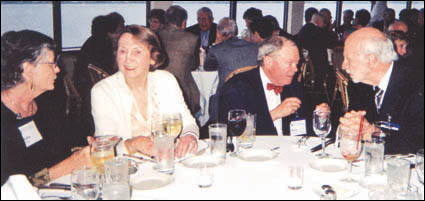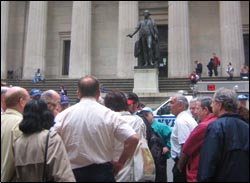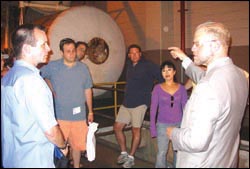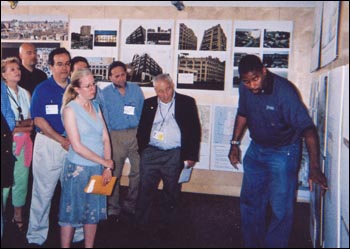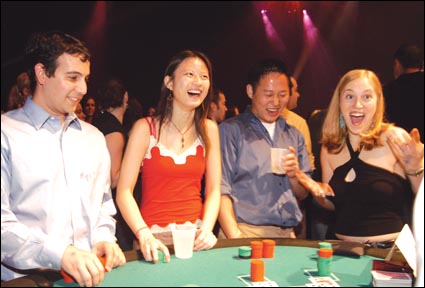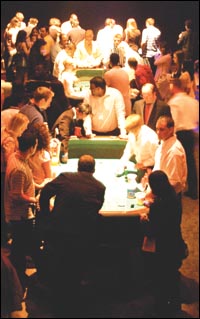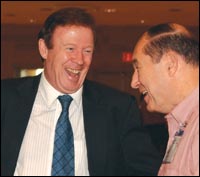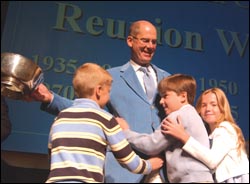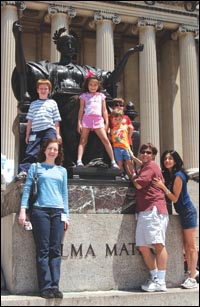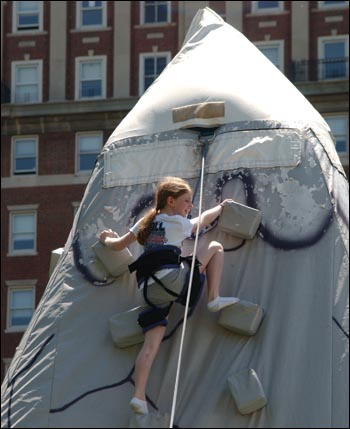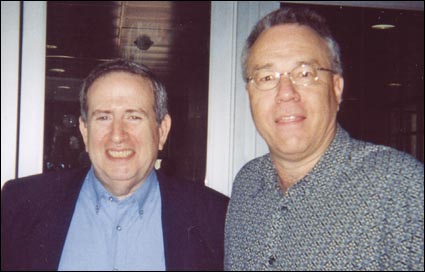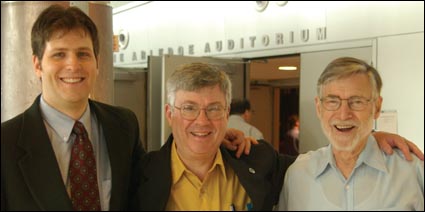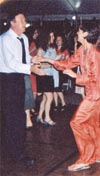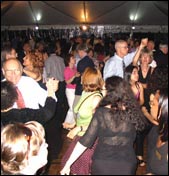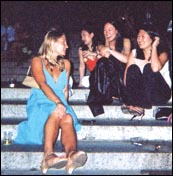|
|
 |
 |
 |
 |
|
FEATURESReunion 2005 Brings Alumni BackAlumni from classes ending in 0 or 5, along with their family members and guests, gathered on campus and at venues around New York City from June 2–5 to celebrate Reunion Weekend 2005. Attendees enjoyed luncheons, dinners, cocktail parties, walking tours, Broadway shows, classroom lectures and panel discussions throughout the weekend, with many activities to choose from as well as free time to spend with classmates. CCT contributing writer (and reunion celebrant) Claire Lui ’00 took to the streets, the tunnels, the Roone Arledge Auditorium and the Hammerstein Ballroom to chat with alumni about their reunion and College experiences. “Class of Destiny” Celebrates Its 50thThe Class of 1955 had an enthusiastic turnout, setting a record for a 50th reunion class with 141 alumni and 118 guests in attendance. While waiting on 116th and Broadway to leave for class tours of the Metropolitan Museum of Art and MoMA, ’55ers reminisced about their College days and speculated about the origin of the class nickname, “The Class of Destiny.” James Gherardi ’55 claimed that the class moniker came from a desire to prove that it was better than the Class of 1954 (“The Bicentennial Class”) and pointed to the class’s large turnout for reunions and generous annual giving as proof of its prowess. With Jerry Sherwin ’55, former president of the Alumni Association, and an active reunion committee leading the charge, the Class of ’55 became the first 50th reunion class to surpass 50 percent participation. Several other alumni suggested that the nickname had come from ’55 being the first class to launch a panty raid at Barnard. Only one raid of consequence was remembered, an event that now is a significant memory for many. Some alums spoke about the raiders gathering throughout the dorms before swarming across the street. Alumni described how, once they reached Barnard, the women were throwing underwear out the windows and eventually called the police. To illustrate the story, Eddie Goldberg ’55 sprinted to the Barnard gates to point out the site of the event.
Several alumni recalled the Met and MoMA as favorite haunts. Gordon Kaye ’55 spoke about “living at the MoMA every Wednesday afternoon,” a day he didn’t have classes, and Jeffrey Broido ’55 chatted with his friends about visiting MoMA when Picasso’s Guernica was there. At the museums, old Art Humanities lessons were revived as alumni went on guided tours. Kaye observed that MoMA once charged just 35 cents for admission compared to its current $20 fee.
For many alumni who had grown up in New York but moved away, reunion was an opportunity to see not only how the College has changed, but also the city. Some alumni compared their on-campus reunion lodgings to their days in the dorms, while NYC alumni from DeWitt Clinton, Stuyvesant and other city high schools recalled commuting to the College. Carman Hall, where many alums were housed for the weekend, was a tennis court in the ’50s, and opinions among ’55ers were mixed as to whether it was an improvement over their Hartley and Livingston (now Wallach) digs as students. The Class of 1955 graduated the same year that the Dodgers beat the Yankees to win the World Series, a milestone well remembered by baseball fans such as Ivan Leigh ’55. Leigh noted that his joyful recollection of that baseball season was tempered only by the terror of taking finals in the gym. Contemplating the many changes that Columbia has undergone through the years, he decided, “The best change was going coed.” Alumni Take Manhattanville
Several tours were offered throughout the weekend, including a walking tour of historic Harlem, journeys through the tunnels that snake beneath the Columbia campus and a visit to Kykuit, the historic Rockefeller estate in the Hudson Valley. Among the most popular tours were a few that led alumni through Manhattanville and detailed Columbia’s expansion plans. Led by Warren Whitlock, director of construction coordination, the tours gave alumni an opportunity to look at the plans and models of the proposed campus as well as a chance to walk around the neighborhood. While walking to and from Prentis Hall on 125th Street, site of the models and plans of the proposed new campus, many alumni were talking about 1968. The alumni were well aware of Columbia’s difficult history with expansion, notably the controversial plan to build a gymnasium in Morningside Park that was one of the issues behind the student demonstrations and building takeovers in 1968.
Whitlock gave a thorough overview of the University’s plans and models, explaining the University’s needs and how the proposed campus, designed by Renzo Piano and the firm of Skidmore, Owings and Merrill, would offer at least a partial solution to Columbia’s ongoing need for more space. A cross-section of alumni attended the presentations, including senior alums such as Norman MacLeod ’35 and younger alums such as Arun Das ’95. MacLeod mentioned the many changes that the campus has undergone in the past half-century, noting as an aside as he walked past the subway that the ride used to cost a nickel. Though some alumni were concerned about community reaction to the proposed expansion, a number offered comments of cautious hope. Michael J. Montgomery ’80 felt that the plans were “respectful to the scale of the neighborhood” but that the project’s biggest challenge would be managing the politics of public perception, a viewpoint Das shared. “Columbia, whether deservedly or not, has a reputation as The Big Bad Landlord,” noted Das. But he thought the University had made a good decision to place the models and plans in an accessible, street level room so that the community could view them easily. Das, like Montgomery, hoped that Whitlock’s ideal of openness and dialogue would continue and the expansion would be able to proceed with community support. A Royale Casino Party
Packed with young alumni, Casino Royale at midtown’s Hammerstein Ballroom on Friday night was filled with the sounds of people gambling their chips for a chance to win Columbia prizes and familiar pop tunes played in the background by DJ Zander (Alexander Chemers ’03). Open to all classes, there was a strong showing from the Class of 2000 for its fifth reunion as well as of alumni from the Classes of 1995–2005, who gambled, danced and partied into the wee hours.
“I think I remember that girl” was a commonly overheard phrase throughout the night as people passed alumni who looked familiar. For many, it seemed like no time had passed — Lainy Destin ’00 described the party as “picking up where we left off” — while others, including Anthony Ramirez ’00, thought “Five years makes a big difference.” A number of young alumni on hand were recent law school graduates, many of whom were taking a break from studying for the bar exam. Abigail Krauser ’00 said, “It’s a strange but great thing to come back for reunion.” Krauser described being five years out of school as a “period of transition,” and indeed, many alums were just embarking on new careers or moving to different cities. Axel Knows Your NoseDean of Alumni Affairs and Development Derek Wittner ’65 got a laugh when he pointed out during his remarks at Saturday’s Dean’s Brunch and Convocation that because of the late-night partying at Hammerstein Ballroom, only a handful of young alumni managed to make it to the morning’s program and buffet. Dean Austin Quigley spoke of the growth and evolution of the College, and Alumni Association President Bob Berne ’60 presented Brooks Klimley ’79 with the President’s Cup in recognition of his efforts in helping his class achieve record attendance at its 25th reunion a year ago.
Afterward, inquisitive alumni found their way upstairs to the Roone Arledge Cinema for the 11 a.m. Reunion Weekend Lecture. Dr. Richard Axel ’67 delighted an attentive and appreciative audience with an overview of his Nobel-prize winning research on the olfactory system that was both educational and entertaining. Axel kept the crowd chuckling, peppering his speech with quotes from Émile Zola and Vladimir Nabokov and using slides of a René Magritte painting and a photo of Gywneth Paltrow. In a quick description of how he ended up studying the science of smells, Axel made fun of his undergraduate and medical school career, telling anecdotes about his glasses falling into an abdominal incision and an early job as a lab glassware washer.
Explaining his research to a non-scientific audience, Axel described his search for the genetics behind the ability to smell and for the “map” in our brains that helps us identify different scents. Pointing out that perception — whether visual, auditory or olfactory — is based on past experiences and guesses, Axel showed a photo of George Bush and Dick Cheney. Upon closer inspection, though, the audience realized that “Dick Cheney” was actually another photo of Bush’s face, with Cheney’s hair and glasses. Concluding his talk with a brief allusion to this year’s controversy surrounding the Middle East and Asian Languages and Cultures department and the principle of academic freedom, Axel spoke of his strong belief in the need for freedom of expression within the University and in the world at large. He cautioned against the idea that “there is knowledge best left alone,” emphasizing that it was not knowledge in and of itself that was bad, but how knowledge was used. Future Lions Go to Camp Columbia
Potential future Columbia students jumped around in a Moon Bounce, scaled an inflatable rock climbing wall, did spin art and waited patiently for a balloon animal of their choice at Camp Columbia, the children’s program on the lawn in front of Hamilton. Some kids followed camp counselors as they played games on the grass, while parents watched the younger children in the play area. Randi Albert ’90 and Daniel Halery ’90, who met during freshman year, took advantage of the activities with their sons, Benjamin and Zachary. Benjamin was an enthusiastic fan of the Moon Bounce, making repeated visits, and baby Zachary napped with his parents. Brian Cousin ’85 also appreciated the children’s zone; one of his three sons enjoyed scaling the rock climbing wall. The play area was a good alternative for his sons, said Cousin, who pointed out that one of the nicest parts of reunion was seeing his classmates’ kids. Camp Columbia, he observed, made it easier for people to bring their children to campus by keeping them occupied while the parents attended events. Some parents with younger children found that a few hours of bouncing and running was enough. Cousin and his wife hired a babysitter for their sons in the evening, while Albert and Halery planned to spend the evening at home with their sons.
Far-Flung AlumniAlumni from all over the world came back to Morningside Heights to attend reunion. The winner for farthest distance traveled was David Luis ’70, who came from Sydney, Australia, although a close runner-up — or should that be a “distant” second? — was Don Shapiro ’65, who came from Taipei, Taiwan.
Shapiro convinced his former Livingston roommate, Richard Lansing ’65, to attend their 40th reunion together. Shapiro, a former Spectator editor-in-chief, attended graduate school at Columbia, studying in a joint program between the East Asian Institute and the Journalism School. In 1969, during his third year, he went to Taiwan to gain practical experience reporting from Asia. In Taipei, he was a reporter for The New York Times. By the end of the year, Shapiro decided he wanted to stay in Taipei a bit longer and cashed in his plane ticket instead of returning home. “I never made a long-range plan to stay,” Shapiro says of the time, but he has lived and worked in Taipei ever since. The editor-in-chief of Taiwan Business TOPICS, a magazine published by the American Chamber of Commerce, Shapiro lives with his wife in Taipei. The couple has two daughters, one living in the U.S. and the other in Taiwan. A Columbia Trifecta: ’35 — ’65 — ’00The Columbia underground tunnel tours were a popular reunion event. One tour was attended by three generations of Columbians: Jerry Schaul ’35, Mike Schaul ’65 and Nissim Schaul ’00. Counting Jerry’s late father, Jerome (Class of 1909), Nissim Schaul is the fourth generation of his family to attend the College.
The three Schauls had been to the tunnels during their undergraduate years, though none remembered any particular underground hijinks. Indeed, Jerry scoffed and said he was a “trouble receiver,” not a “troublemaker.” Though the tunnels were closed by the time Nissim attended, he is probably the Schaul with the most tunnel experience, as he had been granted special access to them when he briefly had to get around on crutches while a student. He acknowledged that he had explored the tunnels a little, but mainly remembered their low ceilings, darkness and scary atmosphere. Mike only remembered using the tunnels to avoid bad weather and described them as “strictly utilitarian” in his time. Jerry also remembered the tunnels as useful conduits. Many tunnel tour attendees had heard tunnel legends, including tales of the tunnels serving as a delivery route for the Manhattan Project, or as sites for illegal exploration. They also were said to have been access routes to buildings taken over during campus demonstrations. Though graffiti can be seen on some pipes, there was little evidence of much of the mythology that has grown up around the tunnels. Mainly, the tunnels were hot; they connect to various utility rooms and route steam, electricity and gas to the University, so the heat from the boilers made walking through the tunnels an almost tropical experience. Norman Skinner ’50 Looks BackNorman Skinner ’50 was one of the few students of color during his time at Columbia. A founding member of the Black Alumni Council, Skinner remembers his College days fondly, recalling that he “was a big man on campus without knowing it.” In addition to being a baseball and basketball team member, he was vice president of his class and a member of Nacoms. Skinner says his undergraduate days were free of racism, and he credited the deans as wonderful influences on the College’s atmosphere. He recalled the surprise shared by him and his two roommates, when moving into his dorm room in Hartley, that everyone in the suite was black. The following year, Skinner decided to live in a single room in Livingston, and upon moving in, he again found that housing had placed him adjacent to two other black students. Chuckling, Skinner recalled, “It didn’t bother us.” Though he was unable to go on the Manhattanville tour, Skinner, a lifelong New Yorker, is planning to learn more about the expansion, commenting that this time (compared to 1968), “At least the school is listening, and this time talk is going on between the community and the University.” Skinner described reunion as lots of fun, saying it was good to see classmates — a sentiment that was widespread among the more than 800 alumni who attended Reunion 2005
|
|
||||||||||||||||||||||||||||||||||||||||||||||||||||||||||||||||||||||||||||||||||||||||||||||||||||||||||||||||
